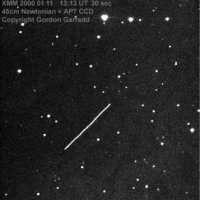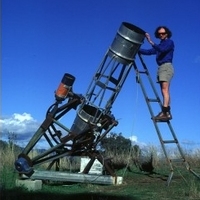XMM observed from Earth
18 January 2000
Following a suggestion from members of the Flight Dynamics department at the European Space Operations Centre (ESOC) in Darmstadt, Germany,an amateur astronomer in Australia has managed to take a picture of XMM in orbit.Gordon Garradd lives in Loomberah New South Wales, some 300 km north of Sydney. He is an extremely avid amateur astronomer. Using a homebuilt 45 cm Newtonian telescope he has already taken many images of orbiting spacecraft, including Cassini and Near. His contributions to astrometric and photometric observations of asteriods and comets for JPL and his work on the minor planets have been rewarded with the "Gene Shoemaker NEO Observing Grant". He even has the honour of having an asteroid (#5066) bearing his name. Garradd is also a freelance photographer with a particular interest in nature subjects including severe thunderstorms!
The CCD image of XMM was taken on 11 January using Garradd's 45 cm f/5.4 Newtonian telescope and an "AP-7" CCD. The CCD has a 512 x 512 array of 24u pixels. Exposure lasted 30 seconds. The spacecraft had emerged from perigee and was at a distance of 44 350 km from Earth.
 |
 |
|
30-second exposure of XMM-Newton in orbit |
Gordon Garradd and the 45 cm Newtonian telescope |
"After many attempts to observe XMM were thwarted by weather - either clouds or high winds - I managed to pick it up on the 11 January through gaps in clouds." recalls Garradd. "Indeed the slight waviness in the image is due to wind buffeting the telescope during the exposure despite the fact that I was standing on my ladder holding up a blanket to try to reduce the effects of wind!"
Finding the spacecraft was made possible with orbital data provided by ESOC and using Garradd's own software. The spacecraft was located about 1/4 degree off where the software predicted it to be, based on elements 2 days old.
Meanwhile, the XMM spacecraft is being put through its paces by controllers at ESOC and particularly by the Science Operations Centre at VILSPA in Spain. The observatory's science payload is working well and the lengthy calibration of its optical and X-ray cameras has commenced. All operations are proceding normally and the first pictures will be released to the public in the next few weeks.

